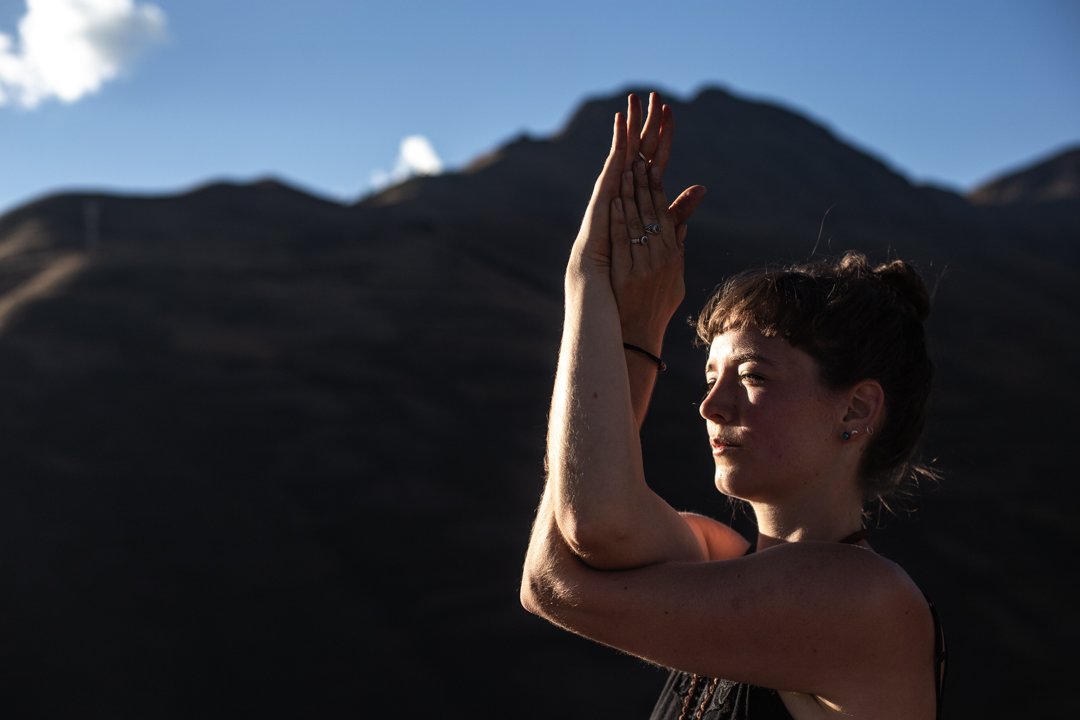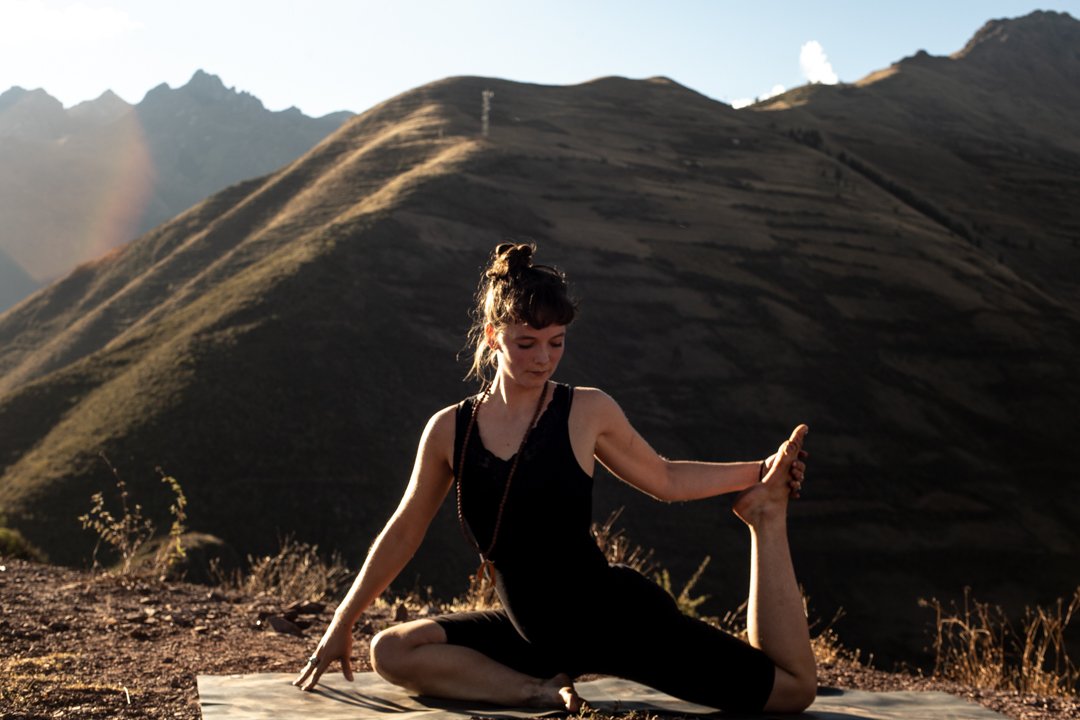How 10 Seemingly Unrelated Health Issues Led to my Hypermobile EDS Diagnosis
Most of my life I felt like there was something happening deep beneath the surface in my body out of sight. It was only in my 30s that I learnt a lifetime of mysterious, and seemingly unrelated health issues, were all intricately connected by one common thread: my genetic condition of Hypermobile Ehlers-Danlos syndrome (hEDS). This condition impacts connective tissue - what holds the whole body together - so it’s no wonder I felt there was something deeper going on all this time! Yoga has been one of the key ways I’ve learned to listen to my body, and advocate for her needs. This blog post shares more of my hEDS story and how it relates to my Yoga practice/ teaching methodology. Read on to learn more.
Jasmine practicing Yoga in the mountains in Peru before she knew she was hypermobile
Understanding Hypermobile EDS: piecing together the complex puzzle of this genetic condition
Ehlers-Danlos syndromes (EDS) encompass a range of conditions affecting connective tissues such as skin, joints, and blood vessels. There are 13 subtypes, and the type I have is hypermobile EDS. It's a complex genetic condition with no cure, varying vastly in its impact on individuals. For me, it became the thread that wove together seemingly unrelated moments in my life when I was finally diagnosed through the NHS aged 30.
Here are some of the issues I exprienced that eventually lead me to seeking a hEDS diagnosis.
Note: I can’t possibly cover everything in one blog post so these 10 points are just a handful of my symptoms/ experiences, there are even more than listed here! As I discuss in my online training Yoga for Hypermobility & Associated Conditions, there are so many symptoms & co-occuring conditions with hEDS!
1. Yoga Teacher Training and my Sacroiliac Joint Injury
Twice, I had to cancel my first ever residential Yoga Teacher Training due to excruciating back pain caused by my sacroiliac joint slipping out - or what I now understand to be subluxing. Little did I know, this was linked to hypermobility and subluxations, two key features of hEDS. In particular, this kept happening during the pre-menstrual phase due to hormonal changes leading to increased laxity. Once I understood the problem I could adapt and stabilise.
2. My High School Neck Injury and Cervical Instability
A simple stretch in high school led to a neck injury that had me off school in excruciating pain. My neck has bothered me ever since - 17 years and counting. Only recently I learned this is likely due to craniocervical instability, a consequence of loose ligaments common in hEDS. Also people with hEDS often experience muscular imbalances due to joint instability, which could lead to overuse or improper engagement of muscles in the shoulder and neck area, as well as coathanger pain.
3. Fainting: Orthostatic Hypotension Diagnosed
I first fainted in a Yoga class during adolescence but the doctor dismissed me saying “it’s normal for teenage girls to faint.” After frequent fainting or dizzy spells upon standing throughout my adult life, I was finally offered an active stand test and was diagnosed with orthostatic hypotension, a type of dysautonomia. Orthostatic hypotension is a condition characterised by a sudden drop in blood pressure upon standing, leading to dizziness or fainting. OH, POTS, and other forms of dysautonomia are common co-occurring conditions with hEDS.
4. Anaphylactic Shock: Emergency Incident
Aged 18 I had to go to A & E due to a life threatening episode of anaphylactic shock during my time living in Cornwall at univeristy. My tonge swelled up till I couldn’t talk. I kept collapsing and losing consciousness until I received treatment at A + E. It wasn't until my hEDS diagnosis over a decade on that I understood its possible link to Mast Cell Activation Syndrome (MCAS), prevalent in those with EDS. I have many other MCAS symptoms but it’s hard to get diagnosed and treated here in the UK.
5. Autoimmune Disease: Coeliac
At 18, after years of being dismissed as "just anxious" when I saw the GP about my symptoms, I was finally diagnosed with coeliac disease. The link between EDS and autoimmune conditions like coeliac disease shed light on my health struggles. Beyond celiac say "A study found that those with celiac disease have a 49% increased risk of EDS than those without celiac disease. The opposite is true, too: people with EDS are more likely to have celiac disease than those without EDS."
6. Exercise Intolerance: Struggling to Keep Up
I've always found exercise more difficult than my peers and have struggled to keep up. I remember at age 13 I was made to run in PE. Afterwards I felt so dizzy, nauseous and fatigued that I fell asleep in English class! As an adult the struggle continued. I always found hiking so much harder than my peers. Little did I know that this was all related to my hypermobile EDS. People with hypermobility can struggle with exercise intolerance due to increased joint laxity and inefficient muscle stabilisation, leading to fatigue and discomfort during physical activity.
7. Tooth Surgery: Anaesthetic Resistance and Delayed Healing
A wisdom tooth extraction surgery in Peru underscored more aspects of EDS - dental issues, resistance to local anaesthetic, and delayed wound healing. Without going into all the gory details, this whole experience was traumatic and my recovery process was very slow. After the initial surgery wound recovery, it took a full 6 months to fully heal from the nerve damage I was left with due to complications. People with EDS may experience a range of dental complications due to the condition's impact on connective tissues and joints.
8. Insomnia: Nights of Restlessness
Chronic trouble falling asleep, vivid dreams, and waking up tired have been part of my life for as long as I can remember. It all made sense when I finally learned about the link between insomnia and hypermobile Ehlers-Danlos syndrome. Insomnia in individuals with hEDS may stem from heightened autonomic nervous system dysregulation, contributing to difficulties in falling asleep and disruptive sleep patterns. Yoga has really helped my insomnia and at the time of writing, even though pain still keeps me up sometimes, generally I am sleeping much better than past me - Phew!
9. Brain Fog and Tummy Troubles: A Deeper Connection
My brain fog and ongoing digestive issues, initially attributed to coeliac disease, persisted despite following treatment for coeliac (which is supposed to make you feel better!) The revelation of gastro symptoms such as nausea, and brain fog being common in patients with dysautonomia, MCAS and hEDS provided some clarity.
10. Neurodivergence: The link between ADHD and EDS
I finally got my official ADHD diagnosis in 2024 - it can take a long time to be assessed. Years of research, familial history, and personal ADHD related struggles/strengths led me to suspect it. Recent studies have found a link between neurodivergence and hypermobile joints with neurodivergence being more common in hypermobile people.
Believe it or not, all of the above still doesn’t even cover the full story! There’s so many pieces to this complex condition. If you’d like to learn more, head to The Ehlers-Danlos Society Website. Read on to discover how my EDS journey connects to my Yoga practice.
Advocacy and Awareness: Shaping the Future of Yoga for People with Hypermobility
Since I received my hypermobile Ehlers-Danlos Syndrome diagnosis, I’ve embarked on a mission to advocate for an under-served population living with EDS and HSD. As a practitioner and enthusiast of Yoga, I'm dismayed by the lack of awareness surrounding hypermobility in Western Yoga teacher training programs and Yoga classes.
Instead of glorifying bendiness, the modern Yoga industry needs to grasp the broader impact of joint hypermobility and how it can affect every system such as musculoskeletal, autonomic nervous system, digestive system, immune system, and more.
Through my personal lived experience, specialised training, and putting the theory into practice, I’ve equipped myself with knowledge on Yoga for Hypermobility.
Over the past year I’ve been sharing more of this as a key part of my work.
Balancing Effort and Ease with Yoga
For everyone, and particuarly those of us with hypermobility, the practice of Yoga requires a delicate balance between activity and rest. Or as ancient Yoga philosophy would call it ‘Sthira and Sukha’ aka Effort and Ease. For me it has been about relearning how to move, how to teach, and ultimately, how to live in a society that is often inaccessible to my unique needs.
Embracing Capacity Management
Living with EDS, for me, has meant learning the art of capacity management - discerning when to move and when to pause, both on and off the Yoga mat. It's a journey of self-discovery, advocacy, and acceptance, one that I'm committed to sharing with others as we strive for a future where healthcare settings, and Yoga classes, recognise and support individuals with hypermobility, Ehlers-Danlos syndrome and related conditions.
Managing chronic health conditions is challenging. Jas is grateful for the practices that help support her.
Yoga for Hypermobility + Associated Conditions Training - On Demand - learn more & enrol here
I’ve created a comprehensive training giving you access to 2 hours of theory training plus supporting resources and a library of pre-recorded classes.
This training is for both hypermobile people and yoga teachers/ movement instructors or therapists of any kind who want to learn more about hypermobility to support their clients/students.



